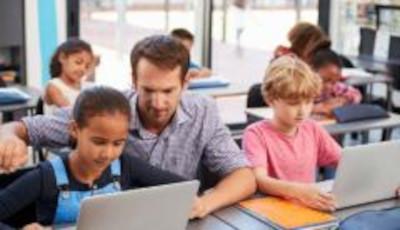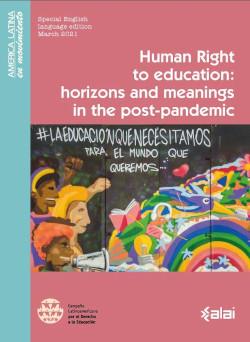Casualization of the teaching profession in times of pandemic
Not only are face-to-face classes interrupted; the process of construction and consolidation of the school territory, with all that it means for society, is interrupted.
- Opinión

| Article published in ALAI’s magazine No. 551: Human Right to education: horizons and meanings in the post-pandemic 05/03/2021 |
The critical limit of the pandemic has not yet passed and the issue of the return to classes is already being discussed. The urgency is justified. Nothing replaces physical presence in the educational routines of the school. Since Comenius, to locate its origin at some point, the configuration of the school space shared by students and teachers became an irreplaceable cultural marker1. The school is a universal iconic institution. The educational act is relational; it is unthinkable otherwise. The school is a habitable space that tames time and leads it through its labyrinths. It does the same with behavior. Anyone who has entered a school when its usual inhabitants are not there has experienced that feeling of strangeness that gives shape to the idea of absence, of emptiness.
The central reference of this cultural marker is the teacher. Students go to school to look for the teacher. This fact determines teaching practice. We speak of the "classroom teacher" to specify his or her job. However, the school is more than the "classroom"; it is a collective sphere of complex relationships that configures a specific ethos. The school is a border territory that relates its inhabitants to the specific environment, to the territory and to the memory associated with it, since the territory is what those who build it make of it. That is why no two schools are alike. Teaching practice is linked to this process of construction of the school territory, to territoriality, to the school ethos (Champollion, 2011). This is the process that has been broken with the confinement produced by the COVID-19 pandemic, which has had clear effects on teachers' work. Not only are face-to-face classes interrupted; the process of construction and consolidation of the school territory, of the school with all that it means for society, and of the role that teachers play in it, is interrupted. The teacher's body has been destructured; all the links that made him/her a specific being, a way of being, have been altered.
The teaching relationship transformed
As the rector of a Colombian university rightly pointed out (Henao, 2020), the pandemic generated syndromes that affected everyone: "abolitionism of the other", "relational paralysis", "social isolationism". And the teacher did not escape them. The context imposed them as preventive imaginaries to avoid contagion. They are all a constituent part of the quarantine phenomenon. Of course, these imaginaries had an impact on the transformation of the relationship between teachers and students that, in the school environment, are unthinkable. In the school, to use an expression of Maturana (2002), referring to the phenomenon of structural coupling, "everyone is the means of everyone".
The teaching relationship was transferred to the virtual environment. But as Deleuzze (2020) points out, the virtual always reacts on the actual; which means that it modifies it, affects it. The living relationship became an imagined relationship, in the sense of a relationship mediated by images, by coded electronic signals coupled to behaviors appropriate to technological mediation. The panoramic vision of the "course", the sensation of shared physical space, body movement, gesture, color, temperature, smells were lost. Image and sound were also distorted, because to avoid congesting the connection it was recommended to turn off the cameras and microphones while not speaking. Simultaneity was replaced by sequentiality.
The pedagogical act, the materialization of teaching work, was strongly impacted by distance education, since the rush generated by the emergency limited the scope of "virtuality". Inequalities in terms of technological infrastructure and cultural capital in families, students and teachers, generated impacts on the teaching work that were not present in face-to-face schooling. In some way, the school space equalized these conditions in a "neutral", common ground. At home, this condition disappeared and educational segmentation deepened. In some cases, there was no access to a computer and in others to a mobile phone or data plan. In other cases, it was necessary to work with physical guides that had to be delivered to the students by whatever possible means.
The material conditions offered by the school for the teachers' work, one of the State's obligations in order to guarantee the right to education, were transferred to the teaching staff: they had to use their own equipment, the electricity in their homes, and pay for data plans. Added to this is the disappearance of the working day, overloading, the blurring of the weekend and rest time. These are features of the labor flexibilization brought about by the adoption of neoliberal policies, which have been incorporated as characteristic features of "entrepreneurship". Of course, a new form of educational privatization has taken place here, characteristic of the adaptation to the conditions imposed by the pandemic.
Curricular impacts
From a strictly pedagogical viewpoint, teaching routines related to curriculum development were also severely impacted. The first concern arose in relation to the possibilities of following the curricular programming. The initial pressures overwhelmed the capacities of all involved. It was impossible to continue with the same routines. The formal curriculum took a back seat. Attention to the daily experiences of the students in their family contexts took precedence. This was a gain. It became more important to learn about daily experiences and the impact of isolation. This is a learning process that should undoubtedly be maintained when returning to face-to-face education, regardless of the modality it assumes, to the extent that the emphasis is placed on the capacity for reflecting on experiences; that is, on the construction of experience, which undoubtedly reinforces the development of critical thinking.
The impact of this transformation has not been sufficiently documented in the field of evaluation. However, it is foreseeable that there have been interesting experiences in this area and, as they become known, it will be possible to systematize them. What has been circulated refers to automatic promotion for the following year, a position that is not well received in the organized teaching profession. The impact on teacher evaluation is also unclear, as it will no longer be possible through student learning achievements by means of standardized census tests.
The annual performance evaluation with an impact on the career ladder is also unclear. School directors and administrators have seen their administrative functions overloaded, further deteriorating their already weakened academic responsibilities. Most of their energy had to be channeled into emergency mitigation actions, especially those related to infrastructure affordability. In a recent CLADE webinar, Martha Alfonso (2011), member of the Executive Committee of the Colombian Federation of Education Workers (FECODE), noted with concern the strengthening of "teacher functionalism", characterized by the concentration on fulfilling "functions" related to standardization, the market, efficiency and effectiveness, to the detriment of pedagogical work; as well as the increased pressure for teacher training related to ICTs, in a sort of retrieval of Freire's literacy proposal in the context of the acceleration of innovation brought about by digital platforms, social networks and apps, the use of which increased in the context of the pandemic.
Work overload and health
A final aspect related to teaching work is the health of teachers. In addition to the risk of infection and death from COVID-19, illnesses related to stress and work overload increased during the pandemic. The aggravation of burnout syndrome stands out: a silent enemy that does not generate evident physical affectations, but cognitive and self-esteem ones, leading to depression, dissatisfaction, lack of commitment and the desire to leave work (Mejía Serrano, Silva Giraldo, & Rueda Mahecha, 2020). This was confirmed in another webinar conducted by the Quindío Node of the Latin American Network of Studies on Teaching Work –Red Estrado Colombia– with participation of teachers from Armenia, Tebaida, Quimbaya, the Association of Official Teaching Directors of Quindío (ADIDOQ) and the Single Union of Education Workers of Quindío (SUTEQ), who reflected on teacher health and teacher working conditions in times of Covid-19, around the questions: What are the implications of work overload and changes in the work space on the life and health of teachers? (Red ESTRADO Nodo Quindío, 2020).
(Translation ALAI)
Omar Orlando Pulido Chaves is an anthropologist. Doctor in Education with emphasis in Pedagogical Mediation. opulido2@gmail.com
REFERENCES
Alfonso, M. (12 - 11 - 2011). 5o. Webinario XI Asamblea Regional de la CLADE: La educación pública en riesgo: Privatización, finaniamiento y docentes. Obtained from Pressenza International Press Agency: https://n9.cl/3z5zq
Champollion, P. (2011). El impacto del territorio en la educación. El caso de la escuela rural en Francia. Revista de Curriculum y Formación del Profesorado, 15(2), 53-69.
Comenio, J. A. (1998). Didáctica Magna (octava ed.). Mexico: Porrúa.
Deleuzze, G. (March 25 2020). Actual y Virtual. retrieved on November 11 2020, at http://lobosuelto.com/actual-y-virtual-gilles-deleuze/
Henao, J. C. (July 6 2020). ¿Llegó la hora de regresar a las clases presenciales? En entrevista con María Isabel Rueda, rector de la U. Externado habla del regreso a universidades. Obtained from https://n9.cl/6i40
Maturana, H. (2002). Transformación en la convivencia: (Segunda ed. ed.). Santiago de Chile: Dolmen Ediciones S.A.
Mejía Serrano, J. C., Silva Giraldo, C. A., & Rueda Mahecha, Y. M. (2020). Ruta de atención psicosocial para docentes con síndrome de Burnout a causas de la cuarentena generada por el COVID-19. Revista de Investigación en Gestión Industrial, Ambiental, Seguridad y Salud en el Trabajo- GISST, 133-143.
Red ESTRADO Nodo Quindío. (August 21 2020). Tertulias Pedagógicas en Cuarentena. Obtenido de https://www,youtube.com/results?search_query-rectoria+gabriela
1 “It is of great interest to the whole Christian Republic, not only to preserve this wholesome custom, but to increase it in such a way that in every well-ordered gathering of men (whether city, town, or place) a school be opened as a common educatory of youth” [CITATION Com98 \p 20 \t \l 2058 ] (free translation).
Del mismo autor
Pandemia
- Gabriela Ramírez Mendoza 07/02/2022
- Jyotsna Singh 06/02/2022
- Gabriela Ramírez Mendoza 06/02/2022
- Richa Chintan 10/01/2022
- Isaac Enríquez Pérez 03/01/2022









